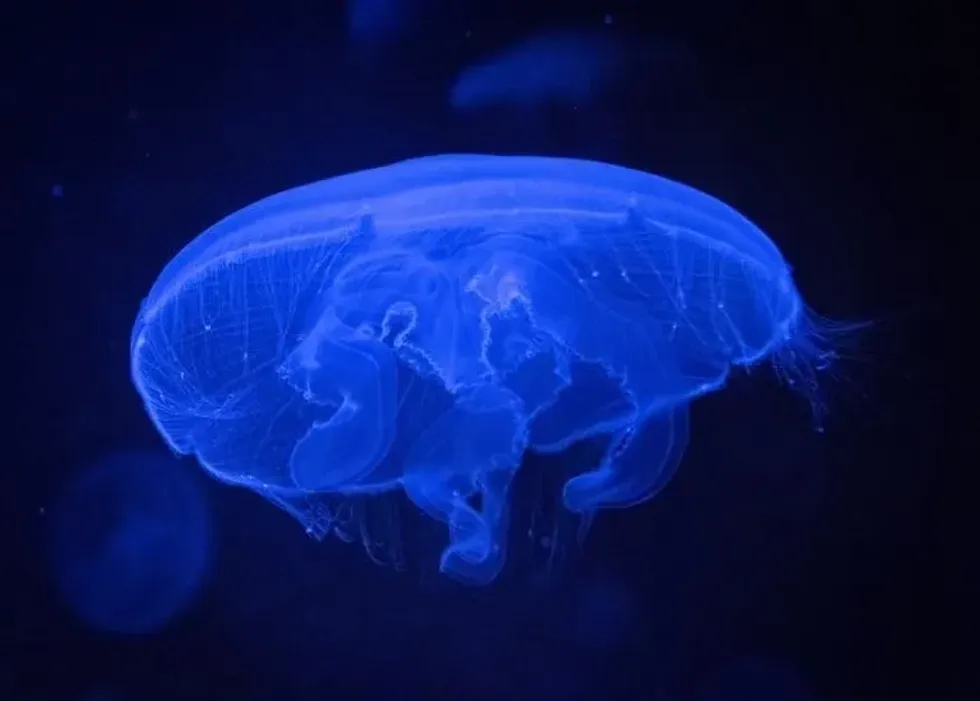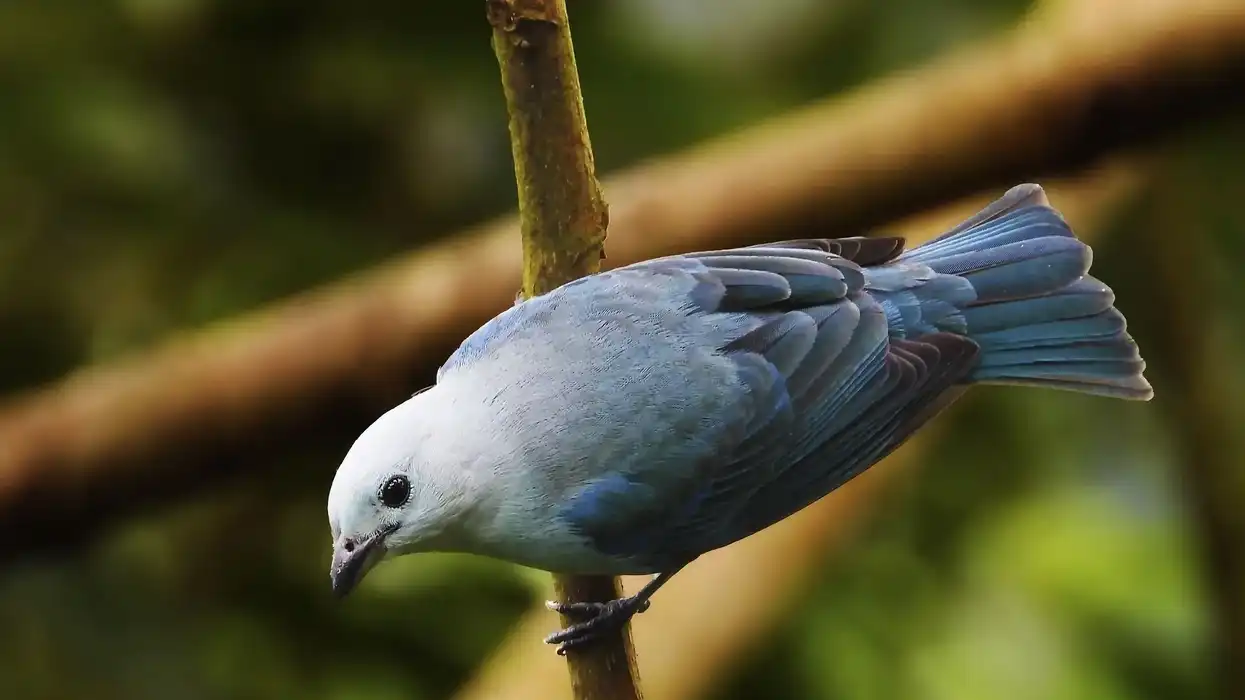Blue jellyfish, also known as the Portuguese man o' war are a species of jellyfish that can be sighted on the beaches of Sydney during summer. These species do not stay very deep in the ocean as they float on the surface.
Since they mostly float on the surface of the ocean, they often get carried off to the beach by the wind. Blue jellyfish can be quite colorful, but they are extremely poisonous, and a sting can be fatal!
They have deadly tentacles and they have ridges and wrinkles in their mouth which can easily catch their prey. Just one sting can paralyze their prey.
While the Portuguese man of war is mainly seen near the Pacific belt, they are also sighted near Australia too. The most interesting fact about these species of jellyfish is that they are not jellyfish as they appear as a colony of minuscule polyps.
If you enjoy reading about blue jellyfish, you can read about the immortal jellyfish and the Irukandji jellyfish here on Kidadl too
Blue Jellyfish Interesting Facts
What type of animal is a blue jellyfish?
As the name suggests, blue jellyfish are blue and can be seen floating on the surface of the sea. This species is seen in a colony and this species is known to be deadly predators as their sting can be fatal.
What class of animal does a blue jellyfish belong to?
Blue jellyfish belong to the Cyaneidae family. Their scientific name is Cyanea lamarckii.
How many blue jellyfish are there in the world?
The exact population of blue jellyfish in the world s unknown. However, they are found in abundance and can be easily spotted.
Where does a blue jellyfish live?
A blue jellyfish (or a bluebottle jellyfish) is seen mainly in the marine region of the Pacific and the Indian Ocean. Their distribution is quite widespread and can also be located in the English Channel, the North Sea, and the Irish Sea too.
What is a blue jellyfish habitat?
During summer, blue jellyfish are seen on the eastern coasts of Australia, and in winter they are washed to the beaches of western Australia. Winds usually carry these jellyfish to the beaches.
Who does blue jellyfish live with?
The blue jellyfish falls under the Cnidaria group and it consists of corals and sea anemones. They are usually found along with Velella and Porpita pacifica. Since they live in water and are a collective colony, you can find them in large numbers. The wind carries them to the shore and here they are seen living with planktons.
How long does a blue jellyfish live?
A man o' war can live for up to one year.
How do they reproduce?
A type of polyp, known as gonozooids, helps bluebottle jellyfish in reproduction. This polyp produces both sperm and eggs and these sperm and eggs unite to form larvae.
What is their conservation status?
Their conservation status is still unknown as they are currently listed as Not Evaluated. However, they are found in abundance and that makes their conservation less of a concern.
Blue Jellyfish Fun Facts
What do blue jellyfish look like?
Though their name suggests that they belong to a particular species or kingdom of jellyfish, they are not. A blue jellyfish is a collective of four co-dependent individuals, known as zooids.
The float is the one that acts as the support system of the colony, the tentacles are responsible for hunting their food and the gonozooids help them reproduce. The float is pear-shaped and is usually blue but at times it can also have hints of green or purple.
They have really long and highly poisonous and stinging tentacles.
Their mouths are covered with stinging cells too which makes it easier to grab their food. When blue jellyfish are young they might look colorless but as they mature they develop a deep blue-purple color.

How cute are they?
Blue jellyfish might be one of the most colorful marine animals and that can make someone perceive them as being cute. However, their poisonous tentacles can be quite deadly, and a sting can ruin your summer vacation so it is important to never touch these jellyfish!
How do they communicate?
Bluebottle jellyfish do not have a brain, unlike most animals. As blue jellyfish are a colony of polyps, their assigned polyps help them to detect their surroundings. They might also camouflage themselves to attract their prey.
How big is a blue jellyfish?
Bluebottle jellyfish can be seen with a blue float and long tentacles. Usually, they can range from 3.9- 7.8 in (10- 20 cm) in size, but there are also instances where they can grow up to 11.8 in (30 cm).
How fast can a blue jellyfish swim?
A blue jellyfish is usually a slow swimmer. As they do not have a brain and they have to rely on their senses, they use their tentacles to locate other marine animals around them. But, once they sense their prey, they can be pretty swift to capture it.
How much does a blue jellyfish weigh?
The exact weight of a blue jellyfish is unknown. Depending on the size of their body and tentacles, this fish species is likely to not weigh much at all.
What are the male and female names of the species?
This species is known to be a species of hermaphrodites so they do not have separate male and female names. Their scientific name is Cyanea lamarckii.
What would you call a baby blue jellyfish?
There is no specific name assigned to a young blue jellyfish. They are commonly called blue button jellyfish though.
What do they eat?
Blue jellyfish are carnivores and they are mostly seen preying on plankton, young crustaceans, eggs, and larvae. They have wrinkles near their mouth which makes it easier to eat their food.
As mentioned earlier, a bluebottle jellyfish is a collective of four colonies known as polyps.
Their digestive region, also known as 'gastrozooids' acts as soon as they sense food near their vicinity. Their mouth can expand up to 0.79 in (20 mm) which helps them to feed on their food and gradually their enzymes cater to the digestive process.
Are they poisonous?
Yes, blue jellyfish are poisonous and the stinging cells on their tentacles can easily paralyze their prey. Many beachgoers mistake this species as harmless and then end up getting stung.
The stinging causes irritation and redness on human skin and can also lead to swelling in the area.
If you are on the beach and have been stung, you should immediately wash the area with salt water and carefully remove the tentacles. Close to 30,000 stinging cases are reported every year on the coasts of Australia and if not treated timely, some of these can lead to complications.
Would they make a good pet?
Blue jellyfish do not have any commercial value and are not suitable pets. Blue jellyfish survive in saltwater bodies such as the oceans and seas; they are wild animals and cannot be tamed.
They have adapted to a specific habitat and they thrive the best under those circumstances so should not be taken out of this habitat. Most importantly, they are poisonous, and though they are not always fatal they can harm humans. Their colorful outlook is deceiving but it is important not to pet them under any circumstances.
Did you know...
Blue jellyfish do not swim but float on the surface of the water instead. The upper part of their body, which is known as the float, is filled with gaseous particles which do not allow them to swim underwater.
Can blue bottle jellyfish sting when dead?
Don't ever capture or touch a dead bluebottle jellyfish as even when they are dead, they still sting!
What are three interesting facts about jellyfish?
Jellyfish are often called 'medusa' as they are in the shape of a bell with tentacles around them. In Greek mythology, Medusa was a woman who had snakes instead of hair and if someone stared at her for a long time, they would get transformed into a stone.
Jellyfish have long tentacles. According to sources, the largest jellyfish in the world has tentacles that grow up to 1063 in (27 m)!
Jellyfish do not have a brain or a heart. Their body comprises 98% of water!
Here at Kidadl, we have carefully created lots of interesting family-friendly animal facts for everyone to discover! For more relatable content, check out these moon jellyfish facts and barrel jellyfish facts for kids.
You can even occupy yourself at home by coloring in one of our free printable blue jellyfish coloring pages.
Thank you to Kidadler Gustavo Lopez Gaspar for providing the image of Blue Jellyfish in this article.










